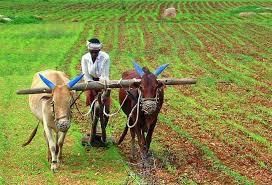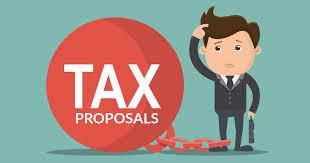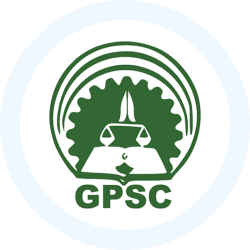GPSC (Goa) Exam > GPSC (Goa) Notes > Goa State PSC (GPSC) Preparation > Goa: Tax and economic reforms
Goa: Tax and economic reforms | Goa State PSC (GPSC) Preparation - GPSC (Goa) PDF Download
| Table of contents |

|
| Introduction |

|
| Agriculture Sector |

|
| Industrial sector |

|
| Tourism |

|
| Tax (Revenue and Expenditure) |

|
| Classification of Receipts and Expenditure |

|
| Goods and Service Tax |

|
| Recent Tax Proposals |

|
Introduction
- The economic liberalization in India, initiated in 1991, introduced the principles of Liberalization, Privatization, and Globalization (LPG) into the country's economic policies. The goal was to create a more market-oriented and service-driven economy while increasing the role of private and foreign investment. Key changes included reducing import tariffs, deregulating markets, lowering taxes, and encouraging greater foreign investment. Proponents credit liberalization with the significant economic growth India experienced in the 1990s and 2000s, and its positive impact is evident in various sectors of the state of Bihar.
- Following the economic liberalization, India's GDP saw a substantial increase, and the Gross State Domestic Product (GSDP) of Bihar also grew significantly. The GSDP at constant (2011-12) prices for the year 2015-16 (Quick Estimates) is estimated to be over ₹37,520 crore, compared to ₹34,611 crore in 2014-15 (Provisional Estimates). This reflects a growth rate of 8.41% in 2015-16, compared to 9.64% in 2014-15.
Agriculture Sector

- In recent years, agriculture has played a crucial role in the economy. To improve productivity in the agriculture sector, three key areas need attention: promoting inclusive growth, enhancing rural income, and ensuring food security. The transformation of agriculture should focus on increasing productivity through investments in efficient irrigation technologies and the effective use of all inputs. The government has set a goal to double farmers' income by 2022, which can be achieved by prioritizing potential crops like cashew, coconut, mango, and paddy, and by boosting their productivity. Various schemes are being implemented to enhance agricultural performance.
- Water availability is a critical factor in increasing agricultural productivity. Irrigation is essential for improving productivity in agriculture. To address this, various schemes are being implemented in the state to expand the area under irrigation and to improve the existing irrigation systems.
Industrial sector
- The economy of Goa is rapidly growing due to accelerated industrial development. The primary goal is to create sustainable employment opportunities, particularly for the local population of Goa. This also includes promoting environment-friendly industrial development that ensures balanced regional growth, and fostering a supportive environment that enables both existing and new industries to thrive by harnessing the potential of the private sector.
- Micro, Small & Medium Enterprises (MSMEs) also play a significant role in boosting the state's gross domestic product (GDP). The Government of India enacted the Micro, Small, and Medium Enterprises Development Act, 2006, effective from October 2, 2016, classifying industrial units into MSMEs based on their investment in plant and machinery. MSMEs contribute to industrial growth and provide employment opportunities to a large number of people in Goa.
Tourism
- Goa's economy is experiencing rapid growth due to increased industrial development. The main objective is to generate sustainable employment opportunities for the local population, while also promoting environmentally friendly industrial growth. This approach aims to achieve balanced regional development and create a conducive environment for both established and new industries by leveraging the potential of the private sector.
- Micro, Small, and Medium Enterprises (MSMEs) are crucial for enhancing the state's gross domestic product (GDP). The Government of India implemented the Micro, Small, and Medium Enterprises Development Act, 2006, which came into effect on October 2, 2016. This act classifies industrial units into MSMEs based on their investment in plant and machinery. MSMEs play a key role in fostering industrial growth and providing significant employment opportunities in Goa.
Tax (Revenue and Expenditure)

- Goa's financial landscape in 2016-17 depicted a revenue surplus of 158.82 crore. The estimated revenue receipts for that year totaled 9,361.96 crore, with expenditure projected at 9,203.14 crore.
- The total receipts for 2016-17 were slated at 11,853.51 crore (B.E), encompassing revenue receipts of 9,361.96 crore (B.E) and capital receipts of 2,491.55 crore (B.E). This marked a 16.60 percent decrease from the Revised Estimates of 2015-16.
- For the same period, total expenditure was estimated at 13,111.19 crore (B.E), including revenue expenditure of 9,203.14 crore (B.E) and capital expenditure of 3,908.05 crore (B.E).
Question for Goa: Tax and economic reformsTry yourself: Which sector has played a crucial role in the economy of Bihar?View Solution
Classification of Receipts and Expenditure
- Receipts can be classified into two main categories: Revenue Receipts and Capital Receipts.
- Revenue Receipts for the state include the share of central taxes, grants-in-aid from the central government, the state's own tax revenue, and the state's own non-tax revenue.
1. Share in Central Taxes
- Goa's Share in Central Taxes comprises Corporation Tax, Taxes on Income (excluding Corporation Tax), Taxes on Wealth, Customs, Union, and Service Tax. The state received 1072.87 crores from the Central Government as State share in Central Taxes and Grant-in-Aid, constituting approximately 15% of its Budget.
- Noteworthy is the substantial increase in Central transfers to the State since 2015-16, in line with the recommendations of the Fourteenth Finance Commission.
2. State's Own Tax Revenue
- Sales Tax (V.A.T), State Excise, Stamp Duty, Registration fees, Motor Vehicles, etc. contribute to the State's Own Tax Revenue.
- The state experienced a notable increase of 1,976.70 Crore from 2012-13 to 2016-17 (B.E), demonstrating an annual compound growth rate of 13.72%.
3. State's Own Non-Tax Revenue
- Revenue from Power and Water Supply are the primary sources of non-tax revenue for the state.
- In 2015-16 (R.E), there was a decrease of 114.40 crore in non-tax revenue collection compared to the previous year. However, in 2016-17 (B.E), there was an increase of 402.39 crore.
4. Grants-in-Aid from Central Government
The central government offers grants to the state for implementing various schemes. These funds are not repayable loans.
- Revenue Expenditure
- Revenue Expenditure can be categorized into Plan and Non-Plan expenditure.
- The annual compound growth rate of revenue expenditure was 16.63% during the period 2012-13 to 2016-17 (B.E).
- Capital Receipts
- Capital receipts are divided into internal debt, loans and advances from the central government, non-debt capital receipts, and public account (net).
- Capital Expenditure
- Capital expenditure, which primarily includes spending on development works and debt repayment under the Plan, constitutes about 99% of the state’s capital expenditure.
- This expenditure has been increasing, rising from ₹1,285.11 crore in 2012-13 to ₹1,804.39 crore in 2014-15, and further to ₹3,354.46 crore in 2015-16 (Revised Estimates).
- Revenue Deficit
- Capital expenditure in the State, primarily for development projects and debt repayment, has been on a steady rise. In 2012-13, it was 1,285.11 crore, which escalated to 1,804.39 crore in 2014-15 and further to 3,354.46 crore in 2015-16 (RE).
- Revenue Deficit: The State witnessed revenue deficits in 2012-13 and 2013-14 but achieved a revenue surplus of 278.44 crore in 2014-15. However, a deficit of 137.09 crore reoccurred in 2015-16 (RE), with a projected surplus of 158.82 crore in 2016-17 (BE).
- Fiscal Deficit: The State's fiscal deficit has been increasing, from -1,137.36 crore in 2012-13 to -1,369.87 crore in 2013-14.
- Primary Deficit: The primary deficit also rose from -336.65 crore in 2012-13 to -479.21 crore in 2013-14, with a temporary surplus of 58.92 crore in 2014-15.
Different types of taxes
- Nearly 70% of the revenue is derived from Commercial Taxes, which include VAT, CST, entertainment tax, luxury tax, green cess, and non-biodegradable waste charges. Revenue from Excise has significantly decreased, dropping from ₹315.31 crore to ₹221.80 crore (up to January 2017).
- The Department of Mines generated a revenue of ₹219.20 crore for the year 2016-17 (up to January 2017), compared to ₹216.30 crore in the previous year. Additionally, revenue from Notary Services has decreased from ₹171.32 crore in 2015-16 to ₹108.83 crore in 2016-17.
Goods and Service Tax
- The Government of India enacted a law to address indirect taxes, with many of these taxes being incorporated into the Goods and Services Tax (GST). The State has actively participated in all GST Council meetings to effectively present its views on issues related to proposed laws, rules, processes, and systems for GST.
- The GST model law has been drafted and discussed by the GST Council, which has also set the tax rate bands for GST. A Committee has been established to categorize individual goods into specific tax rates. To avoid dual authority over taxpayers, cross-empowerment provisions are included in the Acts: State authorities will manage the CGST and IGST Acts, while Central authorities will oversee the SGST Act. The revenue base calculation for States and the formula for compensation for any losses have been decided. The threshold limits for registration and compounding have also been agreed upon. A consensus on these issues is expected to lead to the introduction of GST between July and September 2017.
- The GST regime is anticipated to benefit not only the Central and State Governments but also consumers, businesses, and industries. Under GST, all Central and State taxes will be consolidated into a single tax, which will help reduce the cascading effect or double taxation.
Impact of GST in state
- The Department of Commercial Taxes is fully ready to transition to the GST regime. Once the State GST Act is enacted, which will be presented to the House soon, Goa will be prepared to implement GST by the expected date.
- As a consuming state with a significant role of services in its economy, Goa is expected to benefit from GST. Any potential shortfall in revenue will be compensated by the Union Government.
Recent Tax Proposals

Value Added Taxes
- Registrations, including renewals, under VAT and other Commercial Taxes typically last for three years. However, with the impending introduction of GST by July 1st, current registrations under VAT and other Commercial Taxes will no longer be valid for dealers—except for those dealing in petroleum products and liquor. To ease the burden on such dealers, provisions are being made to waive renewal fees.
- As part of efforts to support environmental initiatives, there is a proposal to exempt VAT on the sale of electric vehicles.
Excise
- A new proposal suggests imposing an additional fee of ₹1,00,000 on manufacturers of high-quality spirits who import Concentrated Alcoholic Beverages for sales to other manufacturers, whether within or outside the State. Additionally, an export fee of ₹10 per bulk litre will be levied on such sales.
- Registration of vehicles older than 15 years may soon see changes, allowing for the adjustment of Road Tax paid on the old vehicle against registration of a new one. Additionally, revisions are proposed for various fees related to land-based and offshore casinos.
Casino Fee Revisions
- Renewal Fees: The fees for renewing licenses for both land-based and offshore casinos are under review. This could potentially affect the operational costs for these establishments.
- Annual Recurring Fees: There is a proposal to reassess the annual recurring fees imposed on casinos, aiming to ensure fair contributions and potentially enhance revenue for regulatory bodies.
- Transfer of License Fees: The fees associated with transferring casino licenses are also on the reform agenda. Adjustments in this area could influence the ease of license transfers and associated costs.
Question for Goa: Tax and economic reformsTry yourself: Which type of revenue receipt includes revenue from Power and Water Supply for the state?View Solution
The document Goa: Tax and economic reforms | Goa State PSC (GPSC) Preparation - GPSC (Goa) is a part of the GPSC (Goa) Course Goa State PSC (GPSC) Preparation.
All you need of GPSC (Goa) at this link: GPSC (Goa)
FAQs on Goa: Tax and economic reforms - Goa State PSC (GPSC) Preparation - GPSC (Goa)
| 1. What are the key sectors contributing to Goa's tax revenue and economic development? |  |
Ans. The key sectors contributing to Goa's tax revenue and economic development are the agriculture sector, industrial sector, and tourism industry.
| 2. How is tax revenue generated in Goa and how is it utilized for economic growth? |  |
Ans. Tax revenue in Goa is generated through various sources such as Goods and Service Tax (GST) and is utilized for funding development projects, infrastructure improvements, and social welfare programs to promote economic growth.
| 3. What is the significance of tax reforms in Goa and how do they impact the overall economy? |  |
Ans. Tax reforms in Goa play a crucial role in improving tax compliance, increasing revenue collection, and promoting economic stability. These reforms help in creating a conducive business environment and attracting investments for overall economic growth.
| 4. How does the Goods and Service Tax (GST) system work in Goa and how has it impacted businesses? |  |
Ans. The GST system in Goa is a unified tax regime that simplifies the tax structure and ensures seamless tax compliance for businesses. It has positively impacted businesses by reducing tax complexities, promoting ease of doing business, and fostering economic growth.
| 5. What are some recent tax proposals in Goa aimed at promoting economic development and revenue generation? |  |
Ans. Some recent tax proposals in Goa include tax incentives for industries, promotion of eco-tourism, and measures to boost agricultural productivity. These proposals are designed to stimulate economic growth and increase tax revenue for the state.
Related Searches














